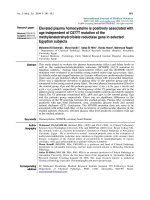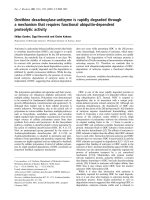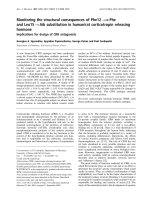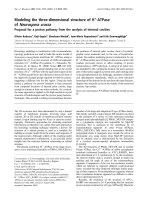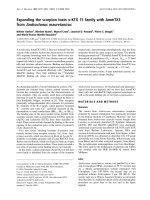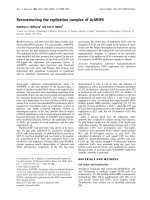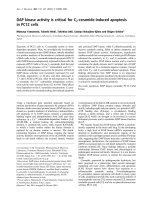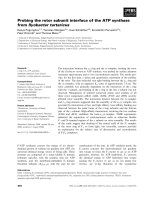Báo cáo y học: "When the pie is too small" pps
Bạn đang xem bản rút gọn của tài liệu. Xem và tải ngay bản đầy đủ của tài liệu tại đây (214.41 KB, 3 trang )
irty-two billion US dollars is a lot of money. It’s more
than the gross national product of Kuala Rokat, a non-
existent but real-sounding country. If it were in pennies
the resulting stack of 3.2 trillion coins would be roughly
5 billion meters high, tall enough to reach from the
surface of the earth roughly a tenth of the way to Mars. In
one dollar bills, which don’t weigh more than a gram, it
would weigh about three times as much as the Eiffel
Tower. Any way you express it, it’s a mighty big pie.
Unfortunately, it’s not big enough.
e Congress of the United States is currently debating
the budget for the National Institutes of Health (NIH),
the world’s largest provider of research funding for bio-
medical science in general (and genome biology in
particular), and $32 billion is the figure they are currently
recommending for fiscal year 2011. If that is the number
ultimately awarded, the biomedical science research
community in the US is going to face some agonizing
choices.
Before the stimulus funding of 2009-2010, the NIH
budget was $30 billion. $32 billion would represent an
increase, but one substantially less than the level of
scientific inflation, which has been averaging about 6% a
year over the past few years. And the base budget was too
small already back then, because of years of declining
funding (in inflation-adjusted dollars) under George W
Bush. e Federation of American Societies for Experi-
mental Biology (FASEB) estimated that $37 billion would
be needed to bring the budget up to where it should be,
and to avoid what some are calling a ‘cliff’ in funding as
the $10 billion in stimulus money that was added to the
base budget last year runs out. My personal view was that
we needed something as close to $40 billion as we could
get. $32 billion isn’t close at all.
ings could change before the final budget is passed,
but I doubt it. Congress is scared to death about the
burgeoning US deficit, which is stupid because we are in
a deep recession with close to double-digit unemploy-
ment and a real interest rate close to zero. Keynesian
economics tells you that in such a situation, where
monetary policy is useless because interest rates cannot
go negative, the government should be spending more,
not less. And spending money on scientific research is
particularly smart, because it has been estimated that
every dollar spent that way rapidly produces 2.0-2.5
dollars of economic output, one of the highest multipliers
for any form of government investment. But the US
Congress has been remarkably spineless of late, and in
the face of calls for fiscal restraint by the political right, it
seems unlikely that we will see an increase in the
proposed amount for the NIH.
ere’s another reason not to expect much, and that’s
because the Democrats are in power. I know, it seems
ridiculous that Barack Obama’s administration, which
actually respects science and listens to its advice, would
leave biomedical research high and dry, but I think they
will. Democratic administrations usually do. e problem
isn’t that they don’t love science, it’s that they love their
favorite social programs more, and there simply isn’t
enough money to fund both at the level they are
clamoring for. e odd thing about US politics (okay, one
of many odd things) is that, with the exception of the
anti-intellectual, science-phobic Bush administration,
Republican governments have been friendlier to scientific
research, in terms of funding, than their Democratic
counterparts. Republicans have largely bought the idea
that funding research, including ‘basic’ research, helps
the competitiveness of the country and jump-starts new
businesses. ere will be a lot more money under Obama
for energy research (the Democrats have completely
accepted the idea that global warming is a huge problem),
but that may well be at the expense of money for the life
sciences.
What, then, does a $32 billion NIH budget mean for
American science? If present trends in funding priorities
continue, it means that the number of individual
investigator-initiated grants (called ‘R01s’ in NIH-speak)
is going to shrink dramatically, as the bureaucrats in
Washington use the precious dollars first to maintain -
and possibly expand - their pet big science programs.
Keeping the cancer genome program and the structural
genomics program and the genome-wide association
studies afloat will require that the R01 pool shrink, and it
is already, in percentage terms, dangerously low.
© 2010 BioMed Central Ltd
When the pie is too small
Gregory A Petsko*
C O M M E N T
*Correspondence:
Rosenstiel Basic Medical Sciences Research Center, Brandeis University, Waltham,
MA 02454-9110, USA.
Petsko Genome Biology 2010, 11:127
/>© 2010 BioMed Central Ltd
Kyle Brown, public policy fellow at the American
Society for Biochemistry and Molecular Biology, has put
together some initial data that illustrate this looming
crisis. Using the total number of R01s and investigators
in a given year, he has calculated the average number of
R01 grants per investigator from 1965 to 2005. e data
were obtained from the NIH RePORT website (http://
report.nih.gov/index.aspx; specifically .
gov/grants/new_investigators/New_Invest_Grants_and_
Numbers.xls).
In 2005, the average number of R01-equivalents per
investigator was 1.35. is average has climbed steadily
since 1970, when it was 1.12, and its rate of increase has
become steeper since the 7-year NIH budget doubling
began in the late 1990s. One interpretation of this trend
is that proportionally more principal investigators (PIs)
are able to obtain more than one grant than they were in
1970. is trend accelerated during the doubling. Taking
this further, it suggests that as the budget has increased,
the NIH is putting more of its money into proportionally
fewer labs.
e distribution of grants per investigator looks expo-
nential and has a mode of 1 (the most investigators have
one grant, the second most have two, the third most have
three, and so on). But perhaps even more important is
the dollar amount, because it is the finite pie that we’re
talking about here. During the past 10 years, a small
number of laboratories and groups of laboratories have
been receiving an increasing share of that pie, as big,
expensive data-gathering projects and programs have
increased at the expense of single-investigator hypothesis-
driven research grants.
ese numbers show why all scientists should fear for
the R01 pool in a time of disastrously small budgets. I am
not sanguine that most of the directors of the NIH
institutes and centers, who control their individual
budgets, are going to be able to resist the temptation to
protect the most visible, glamorous, and disease-related
work while letting the number of ‘basic’ science projects
shrink. It is, therefore, incumbent on us to offer them
solutions to the small-pie problem that keep that from
happening. Here are some ways that have been suggested
of cutting the pie into more slices, predicated on the
assumption - which seems entirely reasonable to me -
that it is better to give an investigator with a good idea
some money than no money at all.
(1) Impose a cap on the maximum dollar amount per R01
grant for direct and, more importantly, indirect costs.
e former are the dollars that actually go to the
investigator(s); the latter are the dollars that go to the
institution to cover the costs of administering the
grant. Indirect cost rates range from around 20% of
total direct costs to over 100% (and yes, that’s not a
typo), so a $1 million grant spread over 5 years can
actually end up costing the NIH $1.5 million or more.
e problem with this strategy is that most research
universities, and medical schools in particular, live on
indirect costs, and an abrupt shutoff of the pipeline
could starve them.
(2) It may be necessary to make people with special long-
term sources of funding, such as those with research
chairs that supply large amounts of research dollars,
or Investigators of the Howard Hughes Medical
Institutes, ineligible for more than one R01 grant on
top of their other funding. An exception could be
made if they were in the 3-year transition period after
being dropped as a Howard Hughes Investigator, or
were about to lose the special funds for any reason.
How to determine whether there is enough special
funding to trigger such a restriction is not obvious to
me.
(3) Impose a cap on the maximum number of R01 total
dollars per PI. I have no idea how to set that figure
fairly given the vastly different costs of clinical and
non-clinical research, but maybe someone else will.
(4) Reduce the maximum duration of an R01 grant
(currently 4-5 years) to perhaps 3-4 years. e burden
this will place on scientists will be considerable, given
that they already spend a huge percentage of their
time writing grants now.
(5) Impose a limit of no more than one R01 equivalent
per PI from any one NIH institute. at would have
the advantage of forcing scientists to become more
interdisciplinary, and the disadvantage of flooding,
say, the National Cancer Institute with applications
from people who know nothing about cancer.
(6) Award percentages of recommended budgets
according to how highly a proposal was rated by the
grants review panel. us, the top 5% of proposals
would receive 100% of their recommended (not
requested) budget; the next 5% would receive 75%,
the next 5% 65%, and the next 5% 50%. is is the
solution I prefer, as it rewards quality while stretching
the research dollars to cover more investigators.
Any of these provisions would need to be reversible
pending a better funding climate. Given the difficulty in
ending any government program, that may be harder to
carry out than the actual spending restrictions, which is
another reason I prefer solution 6 above; it would have
the least severe long-term consequences. e commit-
ment for each institute and center could be to aim for a
payline of, say, 20% of recommended R01 proposals
receiving funding, which they would achieve by cutting
and/or modifying spending using some combination of
these provisions as necessary. (My friend John Kyriakis
owlishly points out that the political climate is just right
to get such ideas implemented. NIH could claim it is
contributing to ‘reducing big government’.)
Petsko Genome Biology 2010, 11:127
/>Page 2 of 3
Of course, an even better solution would be to
terminate some of the pie-hogging big science programs
and put the savings into the R01 pool. at’s what we
should in fact do, so I guess there really isn’t a hope in
hell that we will.
By the way, $32 billion is exactly the sum that BP has
been forced to pay by the US government as a penalty for
the Gulf of Mexico oil spill. I don’t know whether to laugh
at that coincidence or just cry.
Published: 30 July 2010
doi:10.1186/gb-2010-11-7-127
Cite this article as: Petsko GA: When the pie is too small. Genome Biology
2010, 11:127.
Petsko Genome Biology 2010, 11:127
/>Page 3 of 3
